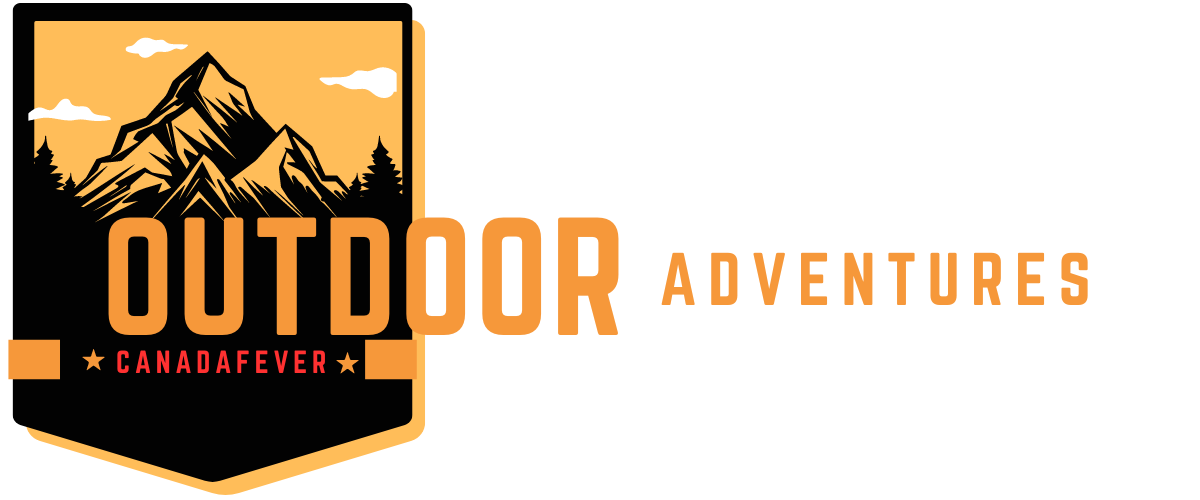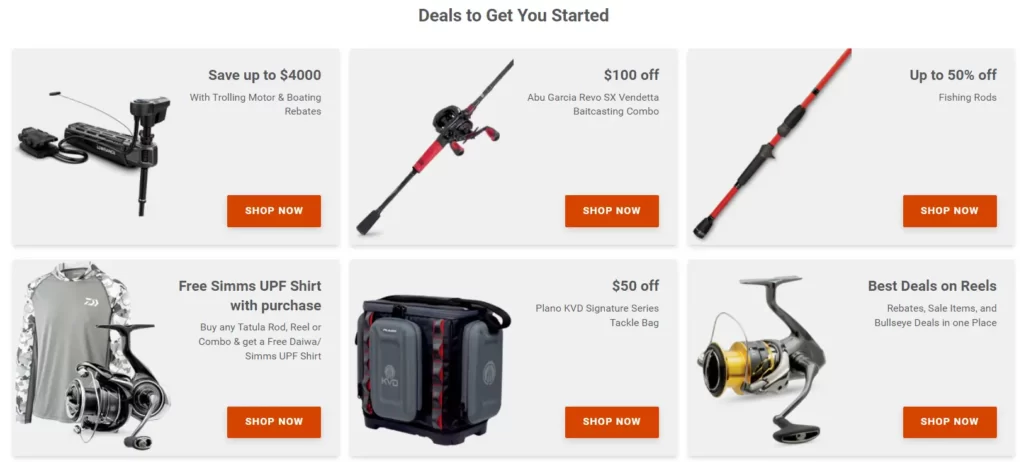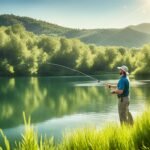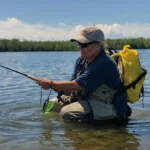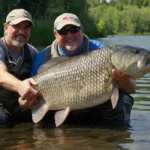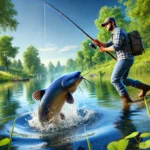Explore Canada's Ultimate Fishing, Hunting, and Wildlife Adventures
Northern Pike Fishing: Master Techniques for Success
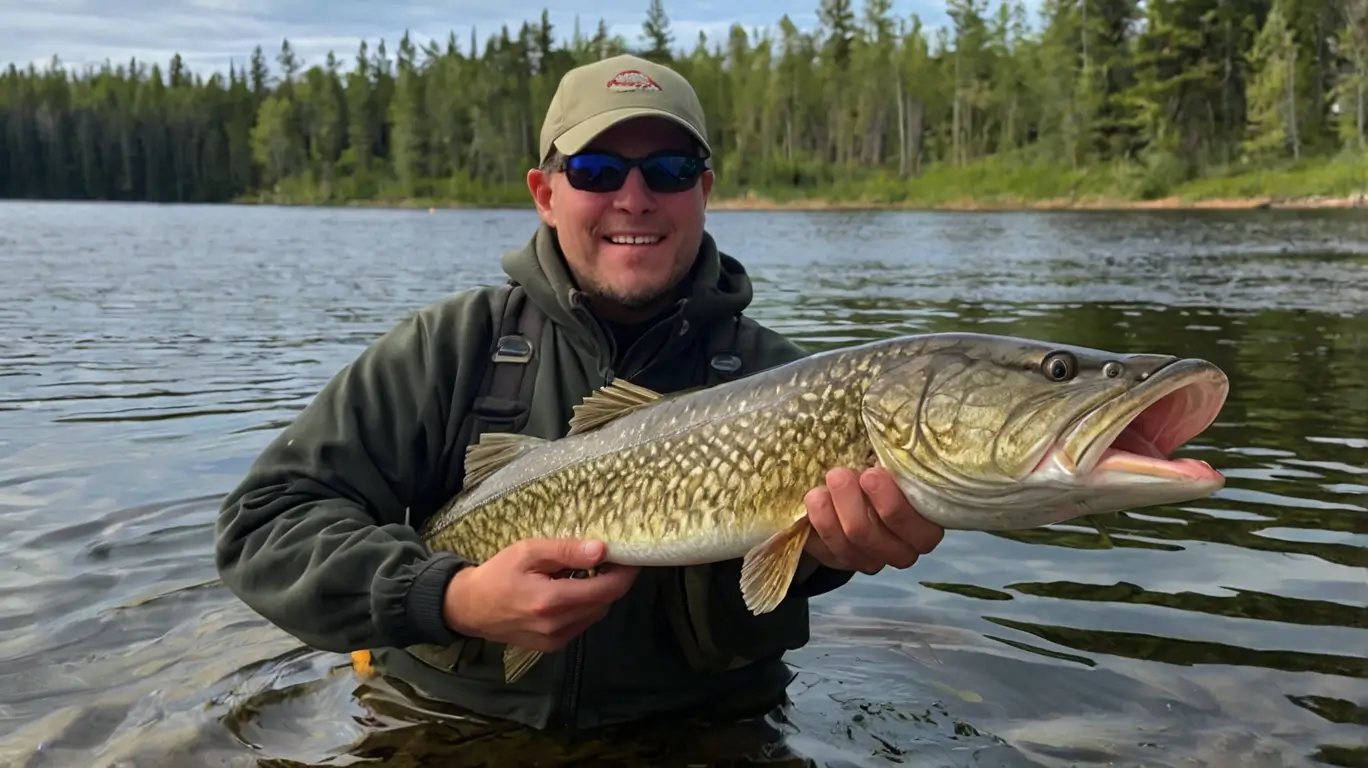
Did you know that pikes, muskellunge, and larger fish can reach lengths of over 4 feet and weigh as much as 50 pounds, making them a sporting fish?
This apex predator, the muskellunge, lurks in the murky waters of the northern hemisphere, ready to strike with lightning speed.
With its elongated body and formidable teeth, the northern pike, also known as muskellunge, is a game fish and a force to be reckoned with in freshwater ecosystems. Whether you’re an avid angler or simply curious about the wonders of nature, join us as we unravel the mysteries of this enigmatic creature.
Key Takeaways about Northern Pike Fishing
- Understanding the behavior and habits of pikes is crucial for successful fishing.
- Preparing for pike fishing involves selecting the right gear, including sturdy rods and strong braided lines for northern pikes.
- Employing effective pike fishing techniques such as trolling, casting, or jigging can significantly improve your chances of catching these elusive fish.
- Proper handling and conservation practices, like using barbless hooks and minimizing air exposure, are essential for the well-being of pike populations.
- Adhering to legal and ethical considerations, such as knowing size and bag limits, ensures sustainable pike fishing for future generations.
- Enhancing your experience by learning from experienced anglers, exploring new fishing spots, and embracing the thrill of pike fishing.
Understanding Northern Pike
Description and Traits
Northern pike, also known as great northern pike or dream northern pike, are characterized by their elongated body, olive-green shading, and distinctive bean-shaped spots.
They possess a duckbill-shaped snout with sharp teeth, and their fins have a distinctive pattern of light-colored spots. The sensory features of northern pike include exceptional vision and a keen sense of smell, allowing them to be efficient hunters in their environment.
The northern pike population has been steadily increasing in recent years, thanks to conservation efforts and improved habitat management. These large predatory fish are known for their aggressive nature and impressive hunting skills.
Northern pike, also known as “water wolves,” are one of the top predators in freshwater habitats. These fish can grow to impressive sizes, with some reaching lengths of over 4 feet and weighing more than 40 pounds.
Their large size and aggressive nature make them a sought-after catch for anglers looking for a thrilling fishing experience. In addition to their popularity among fishermen, northern pike play a vital role in the ecosystem by helping to control the populations of smaller fish, such as perch and walleye.
Disclosure: When you purchase a service or a product through our links, we sometimes earn a commission, at no extra cost to you.
Managing Northern Pike Populations for Ecosystem Sustainability
This helps to maintain a healthy balance within the food chain of lakes and rivers. Researchers studying freshwater ecosystems are particularly interested in the behavior and impact of these apex predators due to their significant influence on the aquatic environment.
Understanding the size variations and growth patterns of northern pike is essential for managing and conserving their populations, ensuring the sustainability of these important fish species for future generations.
Fly to Your Canadian Fishing Paradise
Book cheap flights to Canada's best fishing spots!
One search, all flights
Find the best deals to your favorite fishing spots
Kiwi.com Guarantee
Travel worry-free with our protection
Trusted by millions
Join anglers booking cheap flights with ease
Disclosure: When you purchase a service or a product through our links, we sometimes earn a commission, at no extra cost to you.
Habitat Overview
Northern pike prefer habitats with abundant aquatic vegetation, such as lakes, reservoirs, and slow-moving rivers. They thrive in moderately salty and fresh waters due to their ability to regulate salt levels within their bodies.
These fish are commonly found in North America, Europe, and parts of Asia, favoring regions with cooler temperatures and ample vegetation for spawning.
Geographic Reach
The geographic range of northern pike spans across the Northern Hemisphere, encompassing North America, Europe, and Asia. They exhibit diverse distribution patterns across these regions, adapting to various environmental conditions.
For instance, in North America, they are widespread in the Great Lakes region and northern parts of the continent. In Europe, they are found in countries like Sweden, Finland, and Russia. Similarly, in Asia, they are present in areas such as Siberia and China.
|
Region |
Geographic Range |
|---|---|
|
North America |
Great Lakes region, northern parts |
|
Europe |
Sweden, Finland, Russia |
|
Asia |
Siberia, China |
Preparing for Pike Fishing
Gear Essentials
When targeting northern pike, it’s crucial to have the right gear. A sturdy rod with a medium-heavy action is ideal for handling the strength of these large pike. Pair this with a baitcasting reel that can manage heavier lines and offer better control in reeling in these powerful fish.

Using steel leaders is essential as they prevent the pike’s sharp teeth from cutting through the line. Opt for sized pike lures such as spoons, spinners, and jerkbaits to attract these aggressive predators. The gear should be chosen based on the size of the pike and the specific conditions of the fishing location.
Best Fishing Spots
Renowned for its exceptional northern pike fishing, Lake of the Woods in Minnesota is a prime spot due to its vast expanse and diverse structure. The lake’s numerous bays, islands, and reefs provide ample opportunities to find these elusive giants. Another top destination is Eagle Lake in Ontario, known for producing gargantuan pike.
These locations are attractive to anglers due to their abundance of prey fish, including perch and walleye, which are key elements in sustaining healthy pike populations. Moreover, the thrill of catching a trophy-sized pike in these waters draws anglers from around the world.
- Lake of the Woods, Minnesota is renowned for exceptional northern pike fishing
- The lake’s diverse structure provides ample opportunities to find elusive giants, including northern pike photo.
- Eagle Lake in Ontario is known for producing gargantuan pike
- Abundance of prey fish like perch and walleye sustain healthy pike populations
- Anglers from around the world are drawn to these locations for the thrill of catching trophy-sized pike
Pike Fishing Techniques
Timing and Season
Northern pike fishing is most productive during the spring and fall seasons. During spring, when the water temperature rises, pike become more active, feeding heavily after the winter months. In contrast, fall offers another peak period for pike fishing as they prepare for winter and feed voraciously. Understanding these seasonal patterns is crucial for successful pike angling.
Factors such as water temperature, light conditions, and spawning behavior influence the movement of northern pike. In spring, they tend to move to shallow waters for spawning, making them more accessible for anglers. Conversely, in fall, they move to shallower areas to hunt as they prepare for winter. Anglers should plan their trips accordingly to capitalize on these behaviors.
To maximize success, anglers should plan their trips during dawn or dusk when pike are most active. The low light conditions during these times make it easier for pike to ambush their prey, presenting prime opportunities for anglers.
Bait and Lures
When it comes to bait and lures for northern pike, using large, flashy spoons and spinners can be highly effective. live bait such as large minnows or sucker fish can entice even the most cautious pike. These natural baits mimic the movement of live prey, making them irresistible to pike.
For lures, pike flies are a popular choice among anglers. They imitate small fish or other prey species, attracting pike with their lifelike movements. Other effective lures include jerkbaits and crankbaits, which create erratic movements in the water, triggering aggressive strikes from pike.
Anglers should adapt their bait and lure choices based on the prevailing conditions. During periods of low light or overcast days, using brightly colored lures can enhance visibility and attract pike from a distance.
Casting Methods
Various casting methods can be employed to target northern pike effectively. When using spinning gear, employing a technique known as “figure-eighting” at the boat’s side can provoke strikes from following pike. This involves creating a figure-eight pattern with the lure just below the water’s surface, enticing pursuing pike to strike.
Another effective method is jigging, where the angler imparts an up-and-down motion to the lure by raising and lowering the rod tip. This mimics injured prey struggling in the water, attracting nearby pike looking for an easy meal.
When using live bait, employing a slip-bobber rig allows anglers to present the bait at specific depths, ensuring it remains within the strike zone of pike that might be holding at different depths within the water column.
Pike Behavior and Habits
Feeding Patterns
Northern pike are voracious predators, known for their aggressive feeding behavior. They exhibit a diel rhythm, being most active during dawn and dusk. Their diet primarily consists of smaller fish such as perch, minnows, and even their own species. They feed on amphibians, small mammals, and waterfowl.
Understanding the feeding patterns of northern pike is crucial for successful fishing. Anglers can strategically choose the right time to fish based on the pike’s feeding schedule. By using lures or bait that mimic the movement of their preferred prey, anglers can significantly increase their chances of catching these elusive predators.
Aggression and Hunting
The northern pike’s aggression during hunting is a defining characteristic. They are ambush predators, often lying in wait among aquatic vegetation or near structures before lunging at their prey with remarkable speed and precision. Their elongated body and sharp teeth enable them to swiftly capture their target.
These apex predators employ various hunting strategies, including stalking, ambushing, and chasing down prey. Their ability to camouflage themselves within their surroundings makes them highly effective hunters. Once they spot their prey, they swiftly propel themselves forward with incredible force, striking with a sudden burst of speed.
Their predatory behaviors make them formidable hunters in freshwater ecosystems. The combination of stealth, agility, and explosive power allows them to dominate their habitat, making them a challenging yet thrilling catch for anglers seeking an adrenaline-pumping fishing experience.
|
Hunting Behavior |
Northern Pike |
|---|---|
|
Ambush Predators |
Yes |
|
Stalking |
Yes |
|
Chasing Prey |
Yes |
|
Camouflage Ability |
Highly effective |
|
Speed and Agility |
Remarkable |
|
Power |
Explosive |
|
Dominance in Habitat |
Formidable |
Handling and Conservation
Catch and Release
Northern pike are great game fish, and practicing catch and release is crucial for their survival. When anglers release northern pike back into the water, it contributes to the removal of stress on the fish population. This practice also supports the sustainable management of pike in reservoirs and natural water bodies.
Releasing northern pike allows them to continue their movement within their habitat, ensuring that they can thrive and contribute to the ecosystem. When handled properly, these fish have a high chance of survival after being released.
To safely handle and release caught northern pike, anglers should use appropriate fishing gear, avoid exhausting the fish, and minimize handling time. Supporting the head and body of the fish while removing the hook can prevent injuries and maximize their chances of survival upon release.
Ecological Impact
The presence of northern pike can significantly impact local ecosystems. These predatory fish play a vital role in regulating prey populations, thereby maintaining a healthy balance within their habitats. However, overpopulation of northern pike can lead to a decline in other fish species, disrupting the ecological equilibrium.
In some regions, conservation efforts focus on managing northern pike populations to mitigate their potential negative effects on local ecosystems. For instance, selective removal of mature pike or implementing size limits for harvesting can help control their numbers while preserving the overall ecological balance.
Moreover, monitoring their impact on water bodies is essential for developing effective conservation strategies.
Legal and Ethical Considerations
Regulations in Canada
In Canada, the regulations for northern pike fishing vary by province and territory. Anglers must familiarize themselves with the specific rules governing the area they plan to fish in. For instance, in Ontario, a valid fishing license is required for anyone aged 18-64. There are size limits on northern pike catches to ensure the sustainability of their populations. These limits typically range from 24 to 30 inches.
Moreover, some regions may have specific catch-and-release policies for larger northern pike to protect breeding stocks. It’s crucial for anglers to stay informed about any changes in regulations as they can directly impact their fishing activities. Understanding and adhering to these rules not only ensures legal compliance but also contributes to the conservation of this species.
|
Province/Territory |
Fishing License Requirement |
Size Limits |
Catch-and-Release Policy |
|---|---|---|---|
|
Ontario |
Required for 18-64 years old |
24-30 inches |
Yes, for larger pike |
|
Alberta |
Required for 16+ years old |
Varies |
No |
|
British Columbia |
Required for 16+ years old |
Varies |
Yes, in certain areas |
|
Quebec |
Required for 18+ years old |
Varies |
Yes, for larger pike |
|
Manitoba |
Required for 16+ years old |
Varies |
Yes, in certain areas |
Ethical Fishing Practices
When targeting northern pike, ethical fishing practices play a vital role in preserving the species and their habitat. Anglers should prioritize responsible fishing techniques and handling practices to minimize stress on the fish. Using barbless hooks can aid in easy hook removal and reduce potential injuries to the fish during release.
Respecting the environment and wildlife is essential. This includes avoiding overfishing, especially during spawning seasons, and being mindful of the impact of fishing gear on aquatic ecosystems.
Anglers should be cautious when handling northern pike to avoid harming them. Properly supporting the fish’s body and minimizing air exposure can significantly improve their chances of survival after release.
Enhancing Your Experience
Sport Fishing Tips
When fishing for northern pike, finding the right places is crucial. Look for instances where the water is clear and there’s an abundance of vegetation. These areas are known to attract pike due to the presence of smaller fish.
To enhance your experience, consider using flashy lures or bait. Northern pike are attracted to shiny objects, so incorporating flash into your fishing gear can significantly increase your chances of a successful catch.
Anglers should also be mindful of the large size of northern pike. To handle these powerful fish, it’s important to use appropriate equipment. Ensure that your fishing rod, line, and hooks are strong enough to withstand the strength of a northern pike.
Understanding the sensory pores of northern pike can be beneficial. These pores are located on their bodies and allow them to detect vibrations in the water. By utilizing this knowledge, anglers can adjust their techniques to make their bait more appealing to these predatory fish.
In terms of advanced techniques, mastering the art of casting and retrieving is essential. Practice precision casting near weed beds or other potential hiding spots. This method can entice northern pike to strike at your bait.
Another advanced technique involves learning how to “walk the dog” with topwater lures. This action mimics a wounded baitfish, making it irresistible to northern pike lurking beneath the surface.
- Experiment with different types of flashy lures and bait to see which ones attract northern pike the most.
- Invest in strong and durable fishing equipment to handle the large size and strength of northern pike.
- Research the sensory pores of northern pike and adjust your fishing techniques to make your bait more appealing to them.
- Practice precision casting near weed beds or potential hiding spots to entice northern pike to strike at your bait.
- Learn how to “walk the dog” with topwater lures to mimic a wounded baitfish and attract northern pike.
- Explore different fishing spots with clear water and an abundance of vegetation to find the right places for northern pike.
- Consider using live bait or artificial lures that mimic smaller fish to attract northern pike.
- Study the behavior of northern pike and adjust your fishing techniques accordingly to increase your chances of a successful catch.
- Join a local fishing club or community to learn from experienced anglers and gain valuable tips for fishing for northern pike.
- Take note of the best times of day or year for fishing for northern pike and plan your fishing trips accordingly.
Recording and Sharing Catches
Recording and sharing catches of northern pike holds significant value for both individual anglers and the broader fishing community. Documenting your catches not only serves as a personal record but also contributes to conservation efforts and scientific research.
By documenting catches, anglers can track their successes and failures over time. This information can be used to analyze patterns and improve fishing strategies for northern pike specifically. Keeping a log of catches allows anglers to reflect on their experiences and learn from each outing.
Sharing catches with others also fosters a sense of community among anglers. It provides an opportunity to celebrate achievements, exchange tips, and contribute to the collective knowledge base about northern pike fishing.
Online platforms such as fishing forums, social media groups, and dedicated fishing apps offer convenient ways to share catches with fellow enthusiasts. These platforms enable anglers to showcase their prized catches, engage in discussions, and learn from others’ experiences.
|
Recording Catches |
Sharing Catches |
|---|---|
|
Personal record |
Foster community |
|
Conservation |
Celebrate achievements |
|
Scientific research |
Exchange tips |
|
Track successes and failures |
Contribute to collective knowledge base |
|
Analyze patterns and improve strategies |
Engage in discussions |
|
Reflect on experiences and learn from outings |
Showcase prized catches |
Final Remarks
You’ve gained a comprehensive understanding of northern pike, from their behavior and habits to effective fishing techniques. By preparing adequately and considering legal and ethical aspects, you’re set for a successful pike fishing experience. Remember to handle these fish with care and prioritize conservation efforts to preserve this species for future generations.
Now that you’re equipped with the know-how, get out there and put your newfound knowledge into action. Share your experience with others, and continue learning and adapting your approach to enhance your pike fishing endeavors.
Stay informed about local regulations and conservation initiatives, and most importantly, enjoy the thrill of catching these remarkable freshwater predators.
Discover detailed information and practical tips for targeting specific fish species in Canada on the Fishing for Specific Species page.
Learn about the best techniques, suitable baits, and ideal fishing spots to increase your chances of a successful catch. Whether you’re a beginner or an experienced angler, this guide offers valuable insights to enhance your fishing experience.
Frequently Asked Questions about Northern Pike Fishing
What are some essential tips for pike fishing?
When pike fishing, use strong and sharp hooks, wire leaders to prevent bite-offs, and consider using live bait or lures that mimic the pike’s natural prey. Be mindful of handling techniques to safely release the fish back into the water.
How can I better understand northern pike behavior and habits?
Northern pike are ambush predators that prefer weed beds, shallow bays, and areas with cover. Understanding their feeding patterns, preferred habitats, and seasonal movements can significantly improve your chances of a successful catch.
What legal and ethical considerations should I keep in mind when fishing for northern pike?
Before heading out to fish for northern pike, familiarize yourself with the local fishing regulations and obtain the necessary licenses or permits. It’s also crucial to practice ethical angling by respecting catch limits, handling fish responsibly, and promoting conservation efforts.
How can I enhance my overall experience when fishing for northern pike?
To elevate your pike fishing experience, consider investing in quality gear, staying informed about the latest techniques and equipment, joining local fishing communities or clubs for valuable insights, and exploring various fishing locations to broaden your skills and knowledge.
What are some effective pike fishing techniques to increase my success rate?
Experiment with different retrieval speeds, jerking motions, and depths when using lures. For live bait fishing, try varying your presentation to entice strikes. Adapting your techniques based on the conditions and actively observing pike behavior can lead to more fruitful outings.
External Links
How to tell the difference between northern pike and muskellunge
